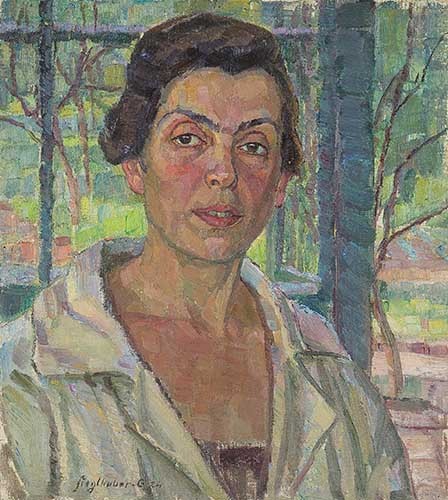
Marianne Fieglhuber-Gutscher
Vienna 1886 - 1978 Graz
Childhood and Adolescence
Marianne Fieglhuber was born on August 12, 1886 in Vienna. Her mother, nee Zifferer, comes from St. Pölten, as does her father, who runs a general store as a respected merchant. She grew up with three sisters and a brother and attended the public school in Mariahilf, Vienna's 6th district.
Study at the Art School for Women
After finishing school, her parents accepted her wish to become an artist and enabled her to study at the Art School for Women and Girls in Vienna, which she began in 1904. This institution, founded in 1897, was the first public art school for women in Vienna, which before that could only be privately taught in painting, sculpture or graphics. She learned the technique of etching from Ludwig Michalek and soon joined the Vienna Artists' Etching Club, which was founded by Michalek's students. As part of the club, she takes part in several exhibitions. Her etchings are shown in Vienna, Salzburg and Leipzig. Marianne Fieglhuber learned painting from Max Kurzweil and Rudolf Jettmar. In addition, she continues her artistic education and undertakes study trips to France, Norway, Sweden and Italy. She joins the Vereinigung bildender Künstlerinnen Österreichs (Association of Female Artists in Austria) and takes part in their annual exhibitions.
Marriage, First World War and 1920s
After her marriage, she went by the double name of Fieglhuber-Gutscher and moved into an apartment with her husband on Sandwirtgasse in Vienna's 6th district, which she also used as a studio. World War I broke out soon after, and her husband was drafted. Their daughter Marianne was born in 1915, followed by their son Eduard two years later. Due to her family obligations, she had little freedom for her artistic work during the war. In addition, her husband, who never understood her painting, returned from the war much changed and strictly rejected her artistic ambitions. However, over the years she asserted herself against him, because fruitful phases followed in her work. She also takes private painting lessons from her younger fellow painters, Robin Christian Andersen and Egge Sturm-Skrla.
1930s and Second World War
In the 1930s she exhibited regularly at the Künstlerhaus and the Vienna Secession. The political developments of those years made her work even more difficult. Marianne Fieglhuber Gutscher is critical of Austria's "annexation" to the German Reich by the National Socialists, not least because some of her friends are of Jewish faith. During the Second World War, she and her family initially lived in an apartment in Vienna.
Post-war years, travel and late recognition
In order to be able to exhibit and sell, Fieglhuber-Gutscher joined the Reichskammer der bildenden Künste (Reich Chamber of Fine Arts) in 1939. In 1943 an exhibition of their works was rejected on the grounds that they did not comply with the "Fuhrer's cultural guidelines". She then retired to the family's second home, a small house in Kasten near Böheimkirchen in Lower Austria. After the end of the war she lives again in the apartment in Vienna's 6th district. From the 1950s she commuted between Vienna, Kasten and Gratkorn near Graz, where her now married daughter lives with her family. In 1956 she received her first commission for a work in public space. She created the “Family” mosaic for the facade of the newly built residential complex at Rechberggasse 16-20 in Vienna’s 10th district. In 1968 the artist also designed a glass window for the Cistercian monastery in Rein. After the death of her husband in 1955, Marianne Fieglhuber-Gutscher began a new, freer phase in her life. She takes part in numerous organized study trips that take her to France, Italy, Spain, Egypt, Belgium, Holland, Sweden, Norway, Greece, Scotland, Finland and the former Czechoslovakia, among others. The time has finally come when she can paint without restrictions and devote herself to the constant development of her mind by reading and listening to music. Since she now spends a lot of time in Graz, she joins the Association of Styrian Visual Artists, but continues to take part in cultural events in Vienna and exhibits there, for example, in the Künstlerhaus. In 1977 her works were shown in the Austrian Gallery in the Upper Belvedere in Vienna. Marianne Fieglhuber-Gutscher died at the age of 92 on January 20, 1978 in Graz. Her grave is at the cementery in Kasten in Lower Austria


